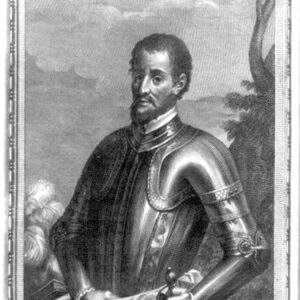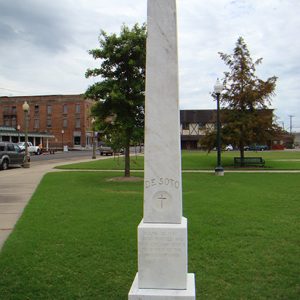calsfoundation@cals.org
Hernando de Soto (1500?–1542)
Hernando de Soto was a Spanish explorer who led an expedition into the southern United States. He and his soldiers were the first Europeans to set foot in what is now Arkansas. Four written accounts of the expedition provide details about his trek through the state.
De Soto was born in the Extremadura region of western Spain around 1500, but the exact date is uncertain. He probably was born in the town of Jerez de los Caballeros. The second son of Francisco Méndez de Soto and Leonor Arias Tinoco, he had at least two younger sisters and an older brother. Although the family was of noble heritage, de Soto was poor and borrowed money to travel to the New World in 1514.
He became a soldier, participating in raids and expeditions in Panama, Nicaragua, and Peru. By 1536, he had gained fame as a cruel but successful military leader in the conquest of Native American groups in Central and South America and had become wealthy from his involvement in the sale of Indian slaves.
Returning to Spain in 1536, he married Isabel de Bobadilla at Valladolid in that November. He petitioned King Charles V for a governorship in Central America, but after complicated negotiations, the king offered him the opportunity to explore and conquer La Florida, which consisted of what is now the southern United States. In addition, de Soto was made governor of Cuba, which would serve as his base for the conquest. In 1537, he began gathering supplies and recruiting a paid army to participate in the expedition.
In May 1539, de Soto set out from Cuba with about 600 men, plus horses, pigs, and equipment. His contract with the king required him to explore the region and establish settlements and forts. After landing on the southwest coast of Florida, the crew traveled through the Southeast before crossing the Mississippi River into what is now Arkansas on June 28, 1541 (June 18 on the Julian calendar, which was used at that time).
The explorers were the first Europeans to set foot in Arkansas. The four known accounts of the expedition describe the Indians they encountered in the next two years. Scholars have long debated the actual route, but archaeologists have discovered small brass bells and other Spanish artifacts at a few archaeological sites—evidence of the expedition.
Three detailed narratives of the expedition were written by survivors Rodrigo Ranjel, Luys Hernández de Biedma, and an unnamed Portuguese soldier. The fourth was written forty to fifty years later by Garcilaso de la Vega from interviews with survivors and appears to have many fictional additions. Although these accounts are biased, together they give a fairly complete picture of de Soto.
The most valuable aspect of the accounts is the portrayal of the Indian groups the expedition encountered. Until the time of de Soto’s death in 1542, the narratives mention the following names of Indian chiefs, towns, and provinces in Arkansas: Aquixo, Casqui, Pacaha, Quiguate, Coligua, Calpista, Palisema, Quixila, Tutilcoya, Tanico, Cayase, Tula, Guipana, Autiamque, Anoixi, Quitamaya, Anilco, Ayays, Tutelpinco, Tianto, Nilco, and Guachoya. Typically, the explorers used the same name to refer to a chief, the town where the chief lived, and the region under his control. Because the names were unfamiliar to the Spanish-speaking explorers, their spellings vary in the different accounts, but they are assumed to be reasonable approximations of the names as spoken by the Indians. They are the first recorded names of anyone living in Arkansas.
Relations with most Indians of Arkansas were relatively cordial, but de Soto and his soldiers thought nothing of torturing and killing those who refused to cooperate. His primary aim was the gaining of riches, and present-day Indians in Arkansas and other Southern states view him as a murderer.
After traveling around the state for almost a year, de Soto led his expedition back to the Mississippi River, somewhere in southeast Arkansas. By that time, he and most of his entourage were disillusioned and tired of the difficult journey and the battles with Indians over the past three years. The gold and other riches they sought were not to be found, and approximately half of the original 600 men had been killed since landing in Florida. None was more disappointed than de Soto, and he sent an exploratory party down the Mississippi to see whether it was feasible to build boats and sail to Mexico. When the men returned a week later, having failed to find the Gulf of Mexico, de Soto fell ill. He apparently was afflicted with some kind of fever and died at a place called Guachoya, believed by some scholars to be modern-day Lake Village (Chicot County), on May 31, 1542 (May 21, 1542, Julian calendar).
De Soto’s death presented difficulties for the expedition members, in part because he had convinced local Indians that he was an immortal “Son of the Sun.” The soldiers explained that he had risen into the sky and then buried his corpse under cover of darkness. Within days, it was obvious that the Indians had noticed the freshly dug soil and were suspicious. Fearing desecration of his corpse and the consequences if the Indians confirmed de Soto’s mortality, the soldiers dug up the body at night, weighted it down, and dumped it into the Mississippi River from a canoe. A little over a year later, the survivors built barges and sailed down the Mississippi, after first trying to travel to Mexico by land.
The de Soto expedition was ultimately a failure. When he arrived in Arkansas, he still saw himself as a gallant conqueror, but, by the time of his death, his spirit was broken.
For additional information:
Childs, H. Terry, and Charles H. McNutt. “Hernando de Soto’s Route from Chicaca through Northeast Arkansas: A Suggestion.” Southeastern Archeology 28 (Winter 2009): 165–183.
Clayton, Lawrence A., Vernon James Knight Jr., and Edward C. Moore, eds. The De Soto Chronicles: The Expedition of Hernando de Soto to North America in 1539–1543. 2 vols. Tuscaloosa: University of Alabama Press, 1993.
Duncan, David Ewing. Hernando de Soto: A Savage Quest in the Americas. Norman: University of Oklahoma Press, 1997.
Hudson, Charles. Knights of Spain, Warriors of the Sun: Hernando de Soto and the South’s Ancient Chiefdoms. Athens: University of Georgia Press, 1997.
Schaeffer, Kelly. “Disease and de Soto: A Bioarchaeological Approach to the Introduction of Malaria to the Southeast US.” MA thesis, University of Arkansas, Fayetteville, 2019. Online at https://scholarworks.uark.edu/etd/3173/ (accessed July 6, 2022).
Young, Gloria A., and Michael P. Hoffman, eds. The Expedition of Hernando de Soto West of the Mississippi, 1541–1543. Fayetteville: University of Arkansas Press, 1993.
Jeffrey M. Mitchem
Arkansas Archeological Survey
This entry, originally published in Arkansas Biography: A Collection of Notable Lives, appears in the CALS Encyclopedia of Arkansas in an altered form. Arkansas Biography is available from the University of Arkansas Press.
 European Exploration and Settlement, 1541 through 1802
European Exploration and Settlement, 1541 through 1802 De Soto Sculpture
De Soto Sculpture  Hernando de Soto
Hernando de Soto  De Soto Monument
De Soto Monument 




This would be a correction of omission since there is so little about de Soto’s often brutal interactions with the Indians. Foremost, the first historical mention of the Chickasaws is from their encounter with de Soto in 1540-1541 when he and his army wintered in their territory, receiving shelter and food. On departure in the spring, de Soto arrogantly made demands of his hosts (including that his army take Chickasaw women with them) and, long story short, they attacked the Spaniards, killing some and relieving them of horses and equipment. They chose not to kill de Soto as his army ran.
Sources: There are several excellent short videos from Chickasaw TV about the tribe’s interaction with de Soto’s army: https://www.chickasaw.tv/profiles/hernando-de-soto-profile
Much is written about this in history articles and texts also.
When I was about ten–fifty-eight years ago–my dad obtained a load of dirt for his garden from the banks of the Arkansas River in Little Rock. I found an interesting object in that load of dirt. I believe it was used on a sword to keep the user from dropping the sword–highly engraved, in Spanish style. Since Hernando de Soto visited the region of what is now Arkansas, I wonder if it could possibly be an artifact from his visit. The Smithsonian Institution indicated it was pre-American Revolution, and European.
The Crow Mountain Petroglyphs were first attributed to Native Americans, then the Vikings, but a recent study suggests that they were carved by the clergy who accompanied de Soto. De Soto retreated to this area after an ill-fated skirmish with the Tula Indians. He overwintered in this area and licked his wounds. (Carrion) Crow Mountain is a mesa-like mountain where he found refuge and could graze his remaining horses and pillage the gardens of Carden Bottoms, just south of there. Skip Stewart Abernathy found relics of the period there.
The carvings were done by educated men, probably the clergy, Cistercian monks. They are aligned with the North Celestial Pole. The Eucharist was important at that time. The circle in the center is the symbol for the Knights Templar. Somebody in recent history has tried to make it into a peace symbol.
The three holes below the circle represent the Trinity: the Father, the Son, and the Holy Ghost. The “V” shaped symbol at the bottom is “the cup” or grail. Parallel lines at the top are unexplained.
The petroglyphs are on private land, but people are invited to visit them. A “bluff shelter” is located across the creek from the petroglyphs.
Donald E. Rickard
Professor Emeritus of Physical Science at Arkansas Tech University